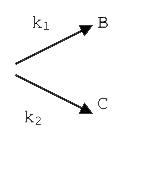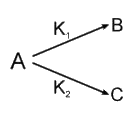A substance undergoes first order decomposition. The decomposition follows we parallel first order reactions as :

k1=1.26×10−4s−1
k2=3.8×10−5s−1
The percentage distribution of B and C areSolution in Punjabi
75% B and 26% C
80% B and 20% C
60% B and 40% C
76.83% B and 23.17% C
Step by step video & image solution for A substance undergoes first order decomposition. The decomposition follows we parallel first order reactions as : k_1= 1.26 xx 10^-4 s^-1 k_2= 3.8 xx 10^-5 s^-1 The percentage distribution of B and C are by Chemistry experts to help you in doubts & scoring excellent marks in Class 12 exams.
Updated on:21/07/2023Topper's Solved these Questions
- CHEMICAL KINETICSBOOK - MODERN PUBLICATIONCHAPTER - CHEMICAL KINETICSEXERCISE - EXERCISE
531 Videos
- BIOMOLECULESBOOK - MODERN PUBLICATIONCHAPTER - BIOMOLECULESEXERCISE - EXERCISE
503 Videos
- CHEMISTRY IN EVERYDAY LIFEBOOK - MODERN PUBLICATIONCHAPTER - CHEMISTRY IN EVERYDAY LIFEEXERCISE - EXERCISE
352 Videos
Similar Questions
How can we express the rates of following reactions in terms of concentration of reactants and products ?
2O3↔3O2
View SolutionComplete the following statement- Uses for solder are-
View SolutionTrue or False : Equanil, used as tranquilizer, is a derivative of barbituric acid.
View SolutionBicyclohexane was found to undergo two parallel first order rearrangements. At 730K, the first order rate constant for the formation of cyclohexene was measured as 1.26×10−4s−1 and for the formation of methyl cyclopentene the rate constant was 3.8×10−5s−1. What is the percentage distribution of the rearrangement Products ?
View SolutionA substance undergoes first order decomposition. The decomposition follows two parallel first order reaction as: and KP_(1)=1.26xx10^(-4)sec^(-1) K_(2)=3.80xx10^(-5)sec^(-1) The percentage distribution of B and C are:
View SolutionA substance undergoes first order decomposition. The decomposition follows two parallel first order reaction as :

The precentage distribution of B and C are :
View SolutionA substance undergoes first order decomposition. The decomposition follows two parallel first order reactions as :
k1=1.26×10−4s−1,k2=3.8×10−5s−1
The percentage distribution of B and C are :

View SolutionThe substance undergoes first order decomposition. The decomposition follows two parallel first order reactions as : K_(1)=1.26xx10^(-4) sec^(-1) and K_(2) =3.8xx10^(-5) sec^(-1) The percentage distribution of B and C
View SolutionA substance undergoes first order decomposition. The decomposition follows two parallel first order reactions as The % distribution of B and C is ................ and .................. respectively.
View SolutionA substance undergoes first order decomposition. The decomposition follows two parallel first order reactions as , k_(1)=1.26xx10^(-4)" sec"^(-1) and k_(2)=3.6xx10^(-5)" sec"^(-1) Calculate the % distribution of B & C.
View SolutionThe substance undergoes first order decomposition. The decomposition follows two parallel first order reactions as :

K1=1.26×10−4sec−1andK2=3.8×10−5sec−1 The percentage distribution of B and C
View SolutionA substance undergoes a first order decomposition. The decomposition follows two parallel first order reactions as

The percentage distribution of B and C are
View SolutionA substance undergoes first order decomposition. The decomposition follows two parallel first order reactios as: and K_(1)=1.26xx10^(-4)"sec"^(-1),K_(2)=3.80xx10^(-5)"sec"^(-1) The percentage distribution of B and C are
View Solutionएक पदार्थ का अपघटन प्रथम कोटि का है। अपघटन निम्न प्रकार से समान्तर प्रथम कोटि अभिक्रिया के रूप में होता है

B तथा C का प्रतिशत विवरण है
View SolutionBicyclohexane was found to undergo two parallel first order rearrangements. At 730 K, the first order rate constant for the formation of cyclohexene was measured as 1.26×10−4s−1 and for the formation of methyl cyclopentene the rate constant was 3.8×10−5s−1. What is the percentage distribution of the rearrangement products ?
View SolutionThe substance undergoes first order decomposition.The decomposition follows two parallel first order reactons as : K_1=10^(-2) sec^(-1) and K_2=4 * 10^(-2)sec^(-1) If the corresponding activation energies of parallel reaction are 100 and 120 kJ "mol"^(-1) then the net activation energy of A is/are:
View Solution
